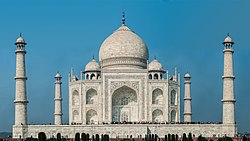Taj Mahal: Difference between revisions
CleanupBot (talk | contribs) (Add {{source}} tag) |
WikiDwarfBOT (talk | contribs) m (→References: Replace {{Source}} tag) |
||
| Line 62: | Line 62: | ||
{{Reflist}} | {{Reflist}} | ||
{{WHSite}} | {{WHSite}} | ||
{{authority control}} | {{authority control}} | ||
| Line 71: | Line 71: | ||
[[Category:Mughal architecture]] | [[Category:Mughal architecture]] | ||
[[Category:17th century establishments in India]] | [[Category:17th century establishments in India]] | ||
{{simple-Wikipedia}} | |||
Revision as of 22:19, 30 April 2021
| Taj Mahal ताजमहल. | |
|---|---|
 Taj Mahal | |
| Location | Agra, Uttar Pradesh, India |
| Coordinates | 27°10′30″N 78°02′31″E / 27.17500°N 78.04194°ECoordinates: 27°10′30″N 78°02′31″E / 27.17500°N 78.04194°E |
| Height | 73 metres (240 ft) |
| Built | 1632–53[1] |
| Architect | Ustad Ahmad Lahauri |
| Architectural style(s) | Mughal architecture |
| Visitors | 7–8 million[2] (in 2016) |
| Type | Cultural |
| Criteria | (i) |
| Designated | 1983 (7th session) |
| Reference no. | 252 |
| State Party | India |
| Region | Asia-Pacific |
The Taj Mahal is a mosque like building and tomb built in the 17th century by the Mughal emperor, Shah Jahan in memory of his wife, Mumtaz Mahal.
The building is in the city of Agra, Uttar Pradesh. Widely thought as one of the most beautiful buildings in the world, it is one of India's biggest tourist attractions.
It is listed as a UNESCO World Heritage Site, together with the Agra Fort, 2.5 kilometers away. It was listed as one of the 7 Wonders of the World in 2007. It is located on the south bank of Yamuna river in Agra. It is a splendid monument, but because of pollution, the Taj Mahal is turning yellow. It Is one of the most notable Islamic architectures built by the Mughals in India.
Construction
The Taj Mahal is an example of Muslim Architecture – a mixture of building design ideas from ancient Indian Indian, persian, and mughal arts.
The Taj Mahal was constructed with materials from all over the world, and over 20,000 people were used to move building materials. It is generally thought that Ustad Ahmad Lahauri was in charge of the construction.[3] The construction was finished in 1648.[4] The construction of Taj Mahal is about 6000 feet..
Tours
The Taj Mahal had 2 million visitors in 2001 and in 2014-2017 there are more than 7-8 million visitors.
Damages
- Many people think it is one of the most beautiful buildings ever built. However, it is slowly being damaged by acid rain in the nearby Yamuna Basin.[5] A nearby oil refinery has been blamed for some of the damage. In 1996, the Indian Supreme Court said that local industry was harming the Taj Mahal.[6] The court set up an area of 10,400 square meters around the Taj Mahal called the Taj Trapezium Zone. Industries within this zone must use natural gas instead of coal.[7]
- Because of pollution Taj Mahal is getting yellower slowly.
References
- ↑ Dutemple, Lesley A (2003). The Taj Mahal. Lerner Publications Co. p. 32. ISBN 0-8225-4694-9. Retrieved 7 February 2015.
- ↑ "Archaeological Survey of India Agra working on compiling visual archives on Taj Mahal". The Economic Times. 29 November 2015. Retrieved 16 January 2016.
- ↑ UNESCO advisory body evaluation.
- ↑ Ganguly, Meenaksy (September 10, 2001). "At The Taj Mahal, Grime Amid Grandeur - TIME". time.com. Retrieved April 2, 2011.
- ↑ "News - Environment: India's famed Taj Mahal is losing its lustre". iol.co.za. Retrieved April 29, 2010.
- ↑ Morley, Ian (April 11, 2007). "ArchitectureWeek - Culture - Saving the Taj Mahal - 2007.0411". architectureweek.com. Retrieved April 2, 2011.
- ↑ "Why is the Taj Trapezium Zone and why is it called so?". Times of India. May 4, 2008. Retrieved April 2, 2011.